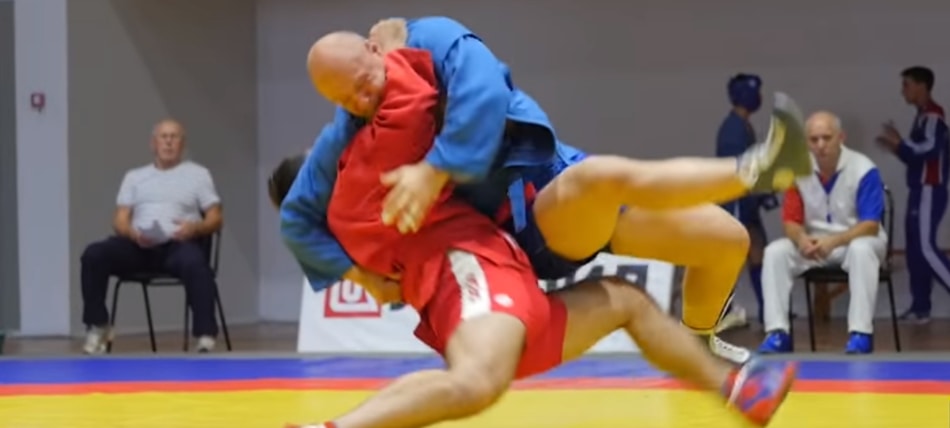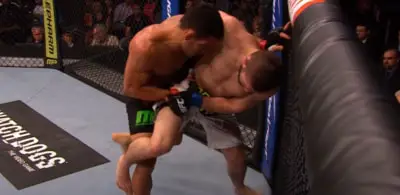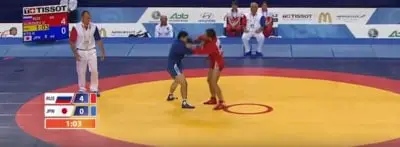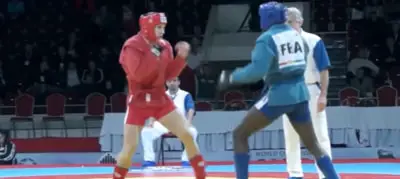
Sambo is a sport that grows in popularity in recent years due to MMA fighters such as Khabib Nurmagomedov that use their sambo skills in the cage and represent the sport. But Sambo is still a relatively unknown sport in western countries. A lot of people don’t know what exactly is the difference between the two types os Sambo – Combat Sambo and Sport Sambo (or just Sambo). And also how is this sport different from other grappling sports such as Judo, BJJ, and Wrestling?
In this article, I’ve tried to summarise all that information:
1. Difference between Sambo and Combat Sambo
In both and combat sambo, the competitors wear jackets and start in a standing position. The main difference is that in sport sambo strikes aren’t allowed. You can’t hit your opponent but submissions such as Leg locks, arm bars, and other submissions (besides chokeholds and rotation leg locks – heel hooks, toe holds) are allowed but
Combat sambo, on the other hand, is almost like MMA. Punches, kicks, soccer kicks, knees, and elbows are allowed and also almost all possible submissions. The differences between Combat Sambo and MMA are that in combat sambo competitors wear jackets, boots and sometimes headgear and shinguards and there is no cage just a mat (like in wrestling).
There is also a freestyle Sambo which is created in the U.S and is the same as sport sambo but chokes are allowed.
| Sambo | Combat Sambo | |
| Olympic Sport | No | No |
| Ways to win | • Have more points at the end of the match • Achieve 12 point lead • Perform a perfect throw* • Submit your opponent | • Have more points at the end of the match • Achieve 12 point lead • Perform a perfect throw • Submit your opponent • Knock your opponent out |
| Equipment | • Jacket • Shorts • Boots | • Jacket • Shorts • Headgear • Mouthpiece • Gloves • Boots • Groin Guard (sometimes) • Shinguards (sometimes) |
| Strikes | No | Yes |
| Time of Origin | 1920s | 1920s |
| Match duration | 5 minutes | 5 minutes |
* A perfect throw is when you take somebody down while you remain standing and the other person falls down on his back or rolls over his back
* There are also wins by disqualification, by injury (when someone can’t continue) and when someone can’t (or don’t want) to continue. But those things are in every sport so I didn’t add them n the table.
Sambo is an abbreviation for self-defense without weapons (in translation). It’s a martial art strongly influenced by judo. Combat sambo is the martial art that Russia teaches it’s soldiers. While sport sambo was the initial martial art for competitions (because it’s much less brutal), there are competitions in combat sambo nowadays also.
Even though all kinds of strikes are allowed in combat sambo, they actually don’t give you any points. Strikes are used mainly to set up takedowns. However, you can win also by knocking out your opponent or make him submit to punches.
2. Difference between Sambo and BJJ
In Gi BJJ competitions competitors wear jackets, pants, and belts while in sambo competitors wear shorts instead of pants, they wear boots and don’t wear belts.
In terms of rules, BJJ focuses mostly on submission instead of takedowns and control. That’s why in BJJ you can pull guard or even sit on the ground to make your opponent engage and attack for submissions. In sambo, pulling guard isn’t allowed, so you need either to take your opponent down or let him take you down if you want to start working on your submissions.
| Sambo | BJJ | |
| Olympic Sport | No | No |
| Ways to win | • Have more points at the end of the match • Achieve 12 point lead • Perform a perfect throw • Submit your opponent | • Submission • Stoppage (when there’s a severe cut for example • Loss of consciousness • More points at the end of the match • Referee decision (when the points are equal the ref should decide who is the winner |
| Equipment | • Jacket • Shorts • Boots | • Jacket • Pants • Belt • Mouthpiece |
| Strikes | No | No |
| Time of Origin | 1920s | 1920s |
| Match duration | 5 minutes | 2-10 minutes depending on your age and belt (and even from 15 min to unlimited time for special tournaments) |
* I used sport sambo for the comparisons because it’s closer to the other grappling sports than the combat sambo
* In this table by BJJ I mean Gi BJJ competition. No-gi has almost the same rules but instead of Gi, competitors wear rashguards, grappling spats and sometimes shorts.
Sambo tries to combine the takedowns and control from judo with the submissions and ground defense from BJJ. However, chokes – the most effective and most used type of submission in BJJ isn’t allowed in sambo
That’s why Freestyle sambo was created. It’s like normal sport sambo but chokes are allowed.
3. Difference between Sambo and Judo
Sport sambo is very similar to judo. Some of the differences are that chokes are allowed in judo (but not in sport sambo) and non-rotation leg locks are allowed in sport sambo (but not in judo). Also in judo when trying to submit someone you can only attack the elbow joint which isn’t the case in sambo. There are fewe grip restrictions in sambo and competitors have more time to work on the ground.
Also in Judo, you can win by pinning your opponent (holding your opponent’s shoulders on the mat for 20 seconds) while in sambo pins just give you points.
| Sambo | Judo | |
| Olympic Sport | No | Yes |
| Ways to win | • Have more points at the end of the match • Achieve 12 point lead • Perform a perfect throw • Submit your opponent | • Perform a perfect throw* • Pin you opponent for 20 seconds • Submit your opponent • Perform almost perfect throw* 2 times • Performing a pin for 10-19 seconds, 2 times |
| Equipment | • Jacket • Shorts • Boots | • Jacket • Pants • Belt |
| Strikes | No | No |
| Time of Origin | 1920s | 1882 |
| Match duration | 5 minutes | 5 minutes (3 min for children and people 30+ years) |
* Perfect throw is when the person you take down, falls down on their back with significant speed or force.
* When you the person falls partly on their back or not with enough force
The idea of Judo was to be the ultimate grappling martial art. In combines takedowns and control with submissions. But nowadays Judo has so many rules and it’s focus shifted more towards takedowns and control than submissions.
Sambo tries to bring the focus back to the submissions by reducing the rules and giving the competitors more time to work on the ground.
4. Difference between Sambo and Wrestling
There are two types of wrestling Greco-Roman and freestyle wrestling. The difference is that in Greco-Roman competitors aren’t allowed to touch the legs of their opponent. In this article, we’ll talk about freestyle wrestling.
A key difference between wrestling and sambo is that wrestling is all about takedowns and control – no submissions are allowed while in sambo you can submit your opponent and win that way.
In Sambo, there are jackets you can grab when performing a takedown while in wrestling there aren’t. And like in judo, in wrestling you can win at any point of the match by pinning your opponent. And as I mentioned, in sambo you get points for that but you don’t completely win.
The difference between the pins in wrestling and judo/sambo is that in wrestling you need to hold your opponent so his/her shoulders are on the mat only for 1-2 seconds in order to score a pin. The conditions are the same in judo and sambo but the time you need to hold your opponent is much longer – 20 sec.
| Sambo | Wrestling | |
| Olympic Sport | No | Yes |
| Ways to win | • Have more points at the end of the match • Achieve 12 point lead • Perform a perfect throw • Submit your opponent | • Pin your opponent for 1-2 seconds • Achieve 10 point lead • Have more points at the end of the match |
| Equipment | • Jacket • Shorts • Boots | • Singlet • Headgear • Handkerchief (in case of bleeding) • Shoes |
| Strikes | No | No |
| Time of Origin | 1920s | Around 15000 years ago |
| Match duration | 5 minutes | Three-2 minute periods with a 30-second break |
Sambo is basically wrestling with kimono-like jackets on. But that can make a huge difference. In sambo, we see a lot of judo throws, because of the better grip you can make with the jacket of your opponent. While in wrestling most of the time wrestlers attack the legs.



